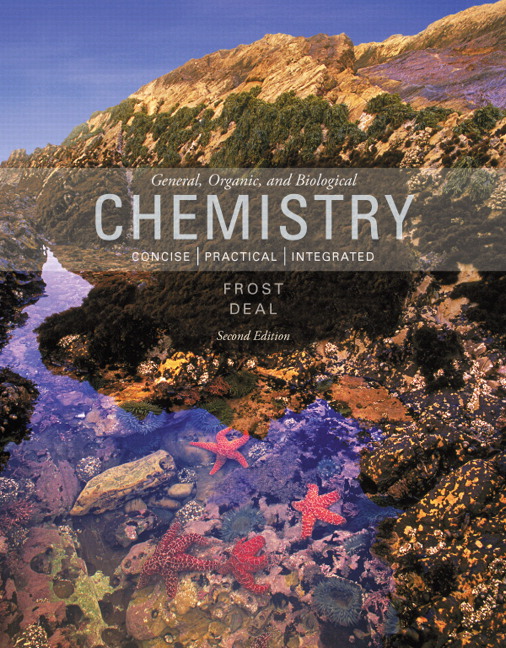Test Bank for General, Organic, and Biological Chemistry, 2/E, Laura D. Frost, S. Todd Deal
$55.00
Test Bank for General, Organic, and Biological Chemistry, 2/E, Laura D. Frost, S. Todd Deal,
You will receive this product within 24 hours after placing the order
Test Bank for General, Organic, and Biological Chemistry, 2/E, Laura D. Frost, S. Todd Deal,
You are buying Test Bank. A Test Bank is collection of test questions tailored to the contents of an individual . Test bank may contains the following types of questions: multiple choice, true/false, fill in the blank, matching, essay/short answer, and free-response questions. Please download sample for your confidential.
Table of Contents
Chapter 1: Chemistry Basics: Matter and Measurement
1.1 Classifying Matter: Mixture or Pure Substance
1.2 Elements, Compounds, and the Periodic Table
1.3 Math Counts
1.4 Matter: The Stuff of Chemistry
1.5 Measuring Matter
1.6 How Matter Changes
Chapter 2: Atoms and Radioactivity
2.1 Atoms and Their Components
2.2 Atomic Number and Mass Number
2.3 Isotopes and Atomic Mass
2.4 Radioactivity and Radioisotopes
2.5 Nuclear Equations and Radioactive Decay
2.6 Radiation Units and Half-Lives
2.7 Medical Applications for Radioisotopes
Chapter 3: Compounds: Putting Particles Together
3.1 Electron Arrangements and the Octet Rule
3.2 In Search of an Octet, Part 1: Ion Formation
3.3 Ionic CompoundsElectron Give and Take
3.4 In Search of an Octet, Part 2: Covalent Bonding
3.5 The Mole: Counting Atoms and Compounds
3.6 Getting Covalent Compounds into Shape
3.7 Electronegativity and Molecular Polarity
Chapter 4: Introduction to Organic Compounds
4.1 Alkanes: The Simplest Organic Compounds
4.2 Representing the Structures of Organic Compounds
4.3 Families of Organic CompoundsFunctional Groups
4.4 Nomenclature of Simple Alkanes
4.5 Isomerism in Organic Compounds
Chapter 5: Chemical Reactions
5.1 Thermodynamics
5.2 Chemical Reactions: Kinetics
5.3 Overview of Chemical Reactions
5.4 Oxidation and Reduction
5.5 Organic Reactions: Condensation and Hydrolysis
5.6 Organic Addition Reactions to Alkenes
Chapter 6: Carbohydrates: Lifes Sweet Molecules
6.1 Classes of Carbohydrates
6.2 Functional Groups in Monosaccharides
6.3 Stereochemistry in Monosaccharides
6.4 Reactions of Monosaccharides
6.5 Disaccharides
6.6 Polysaccharides
6.7 Carbohydrates and Blood
Chapter 7: Whats the Attraction? State Changes, Solubility, and Lipids
7.1 Types of Attractive Forces
7.2 Liquids and Solids: Attractive Forces are Everywhere
7.3 Attractive Forces and Solubility
7.4 Gases: Attractive Forces are Limited
7.5 Dietary Lipids and Trans Fats
7.6 Attractive Forces and the Cell Membrane
Chapter 8: Solution Chemistry: How Sweet is Your Tea?
8.1 Solutions are Mixtures
8.2 Formation of Solutions
8.3 Chemical Equations for Solution Formation
8.4 Concentrations
8.5 Dilution
8.6 Osmosis and Diffusion
8.7 Transport Across Cell Membranes
Chapter 9: Acids, Bases, and Buffers in the Body
9.1 Acids and Bases- Definitions
9.2 Strong Acids and Bases
9.3 Chemical Equilibrium
9.4 Weak Acids and Bases
9.5 pH and the pH Scale
9.6 pKa
9.7 Amino Acids: Common Biological Weak Acids
9.8 Buffers and Blood: The Bicarbonate Buffer System
Chapter 10: Proteins: Workers of the Cell
10.1 Amino Acids-A Second Look
10.2 Protein Formation
10.3 The Three-Dimensional
Structure of Proteins
10.4 Denaturation of Proteins
10.5 Protein Functions
10.6 EnzymesLifes Catalysts
10.7 Factors That Affect Enzyme Activity
Chapter 11: Nucleic Acids: Big Molecules with a Big Role
10.1 Components of Nucleic Acids
10.2 Nucleic Acid Formation
10.3 DNA
10.4 RNA and Protein Synthesis
11.5 Putting It Together:
The Genetic Code and
Protein Synthesis
11.6 Genetic Mutations
11.7 Viruses
11.8 Recombinant DNA Technology
Chapter 12: Food as Fuel: A Metabolic Overview
12.1 How Metabolism Works
12.2 Metabolically Relevant Nucleotides
12.3 DigestionFrom Food Molecules to Hydrolysis
Products
12.4 GlycolysisFrom Hydrolysis Products to Common
Metabolites
12.5 The Citric Acid CycleCentral Processing
12.6 Electron Transport and Oxidative
Phosphorylation
12.7 ATP Production
12.8 Other Fuel Choices












Reviews
There are no reviews yet.